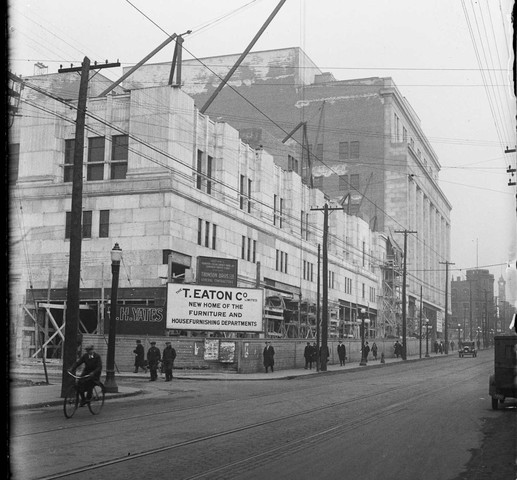
The Heart of Music City: Eaton Auditorium
Eaton Auditorium
Eaton Building, College and Yonge, John H Boyd, 1930. Courtesy of the City of Toronto Archives.
Eaton’s Auditorium Grand Foyer, 7th floor Eaton’s College St store, 1930. Courtesy of the Archives of Ontario, T. Eaton Company Fonds.
Radio advertisement for performances at the Eaton Auditorium, The Globe and Mail, 23 February 1975. Courtesy of the Toronto Public Library.
Summer and Sean Thompson, Heritage Toronto Awards Ceremony, The Carlu, October 28, 2019. Image by Herman Custodio.
Jacques Carlu’s Art Deco dream
The lavish Eaton Auditorium was the crown jewel of the Eaton’s department store empire in Toronto. French architect Jacques Carlu designed the 1275-seat auditorium in the popular Art Moderne style, defined by vivid colours and sleek geometric designs. The auditorium formed only one part of the lavish seventh floor of Eaton’s College Street location, alongside the Round Room restaurant as well as private lounges and dining rooms.
Built in 1930 and formally opened in March 1931, the Auditorium’s debut concert included a performance by the renowned opera singer Florence Austral, accompanied by John Amadio on the flute. Ernest MacMillan, head of the Toronto Conservatory of Music, also performed on the Auditorium’s organ, the largest in Canada at the time, with over 5,800 pipes.
Where Toronto learned to rock
Throughout the 1930s and 1940s, Eaton Auditorium became a cultural hub for music and performances in Toronto. The auditorium was the former home of the Eaton Operatic Society. Made up of Eaton employees, the Society staged regular performances at the Auditorium, often by Gilbert and Sullivan.
By the late 1940s, the Auditorium began to feature modern music performances. In October 1946, American folk and blues musician Josh White opened the Musical Arts series at the Auditorium. White is believed to have been the first Black male artist to sell a million albums with his 1945 hit “One Meatball.”
In 1949, Wynonie Harris performed what is considered to be Toronto’s first-ever rock and roll concert at the Auditorium. Although the concert was formally described as jazz, the newspapers described Harris as “The Good Rockin’ Man”, a reference to his 1948 hit “Good Rockin’ Tonight.”
Glenn Gould’s favourite recording spot
The legacy of Eaton Auditorium is deeply tied to Glenn Gould, one of the most celebrated classical pianists of the twentieth century. At the age of 14, Gould made his professional debut at the Auditorium, performing in the Casavant Society organ series on December 12, 1945.
By the 1970s, Gould was a recognized Canadian icon in music. In love with the Eaton Auditorium’s sound, it became his favourite recording spot for the next decade.
Gould’s last recording at the Auditorium was for a new version of Bach’s Italian Concerto in F Major in late August 1981, one year before his death in October 1982.
“I found no where else on the local scene that suited my needs, though if my arm was twisted – which is not the way one should have it when one is playing the piano – I suppose I would go somewhere else.”
—Glenn Gould
The Carlu
The Eaton Auditorium closed to the public in early 1977. Although the closure was intended to be temporary, the Auditorium never re-opened and became entangled in a decades-long battle to save it from demolition. An $8.5-million restoration of the Auditorium began in 2001.
Opened in 2003, the Auditorium’s name was changed to the Carlu to reflect its original architect, Jacques Carlu. Today, the Carlu operates largely as a private events space and, in recent years, has been home to the Polaris Music Prize and the Heritage Toronto Awards.

